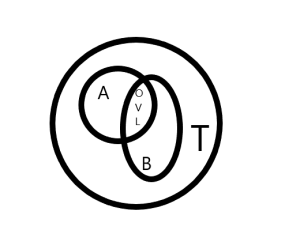The Pythagorean Theorem and Bayes’ Theorem
The Pythagorean Theorem and Bayes’ Theorem are equations. The subject of the Pythagorean theorem is any right triangle. The subject of Bayes’ Theorem is any set containing two subsets, where the two subsets partially overlap one another.
Given the length of the two sides of a right triangle, the Pythagorean equation permits the calculation of the length of the hypotenuse.
Given the ratio of each of the two subsets to the set, and the ratio of the overlap to one of the two subsets, Bayes’ equation permits the calculation of the ratio of the overlap to the other subset.
The Pythagorean Theorem Algebraically
If A and B are the given lengths of the sides of a right triangle, then by the Pythagorean equation, the hypotenuse, C is:
C = (A^2 + B^2)^(1/2)
Bayes’ Theorem Algebraically
If the ratios of two subsets, A and B, to the set T, are given as A/T and B/T and the ratio of the overlap of A and B to the subset B, is given as OVL/B, then by Bayes’ equation, the ratio of the overlap, OVL, to subset A is:
(OVL/A) = (OVL/B) × (B/T) / (A/T)
None of the values, OVL, A, B, and T, is given or calculated by the equation of Bayes’ theorem. The theorem involves only ratios.
Bayes’ Set Geometrically

Pingback: The Logic of the Syllogism and of Bayes’ Theorem in Light of a House and a Condo | theyhavenowine
Pingback: Bayes’ Theorem, Pinocle, and Raphael Lataster | theyhavenowine